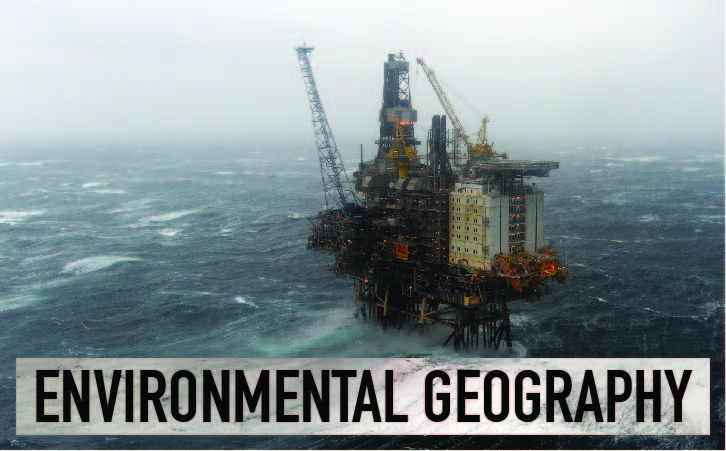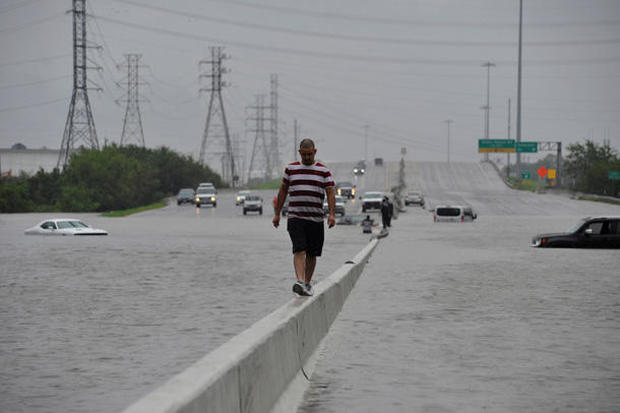Another new class is in the books. This was a fun one to teach and the students brought a lot of really interesting perspectives to the discussions. Hopefully I can run it again soon.
Wintershall’s offshore platform in the Brage oil field in the North Sea.
COURSE DESCRIPTION
In this class, students will engage in a critical examination of environmental transformations that arise from the complex interactions between natural systems and human activities. The pursuit of knowledge about natural resources and ecological systems is a scientific enterprise, yet addressing questions about the production, consumption, distribution, worth, degradation, and preservation of these resources is a historically, politically, and economically specific endeavor. As geographers, then, we cannot simply approach environmental science as an isolated set of fixed principles that exists somewhere in a universe free of humans.
We will attempt to balance our explorations into aspects of the physical environment—like biomes, the carbon cycle, and climate systems—with various social relations that are inextricable from them— like human behavior, social values, identity, power and the state, capitalism and labor practices. The critical approach applied here will encourage students to develop an appreciation of environmental conditions in historical and political context.
COURSE OUTLINE
Introductions: Learning to Die, or, Where do we go from Here?
In, Out, or Around? Social Nature and the Wilderness
Cronon, William.“The Trouble with Wilderness; or, Getting Back to the Wrong Nature.” (William Cronon, ed., Uncommon Ground: Rethinking the Human Place in Nature, New York: W. W. Norton & Co., 1995, 69-90)
Atwood, Margaret. “The animals in that country.” In Atwood, Margaret. The Animals in That Country. Boston: Little Brown & Co, 1969.
Environmental Histories of the Present I: Great Accelerations
Behringer, Wolfgang. A Cultural History of Climate. Cambridge, UK ; Malden, MA: Polity, 2009.
Malm, Andreas. “The Origins of Fossil Capital: From Water to Steam in the British Cotton Industry.” Historical Materialism 21, no. 1 (January 1, 2013): 15–68.
Humanity, Scale, and the Problems with Population
McNeill, J. R., and Peter Engelke. The Great Acceleration: An Environmental History of the Anthropocene since 1945. Cambridge, Massachusetts: Belknap Press, 2016. (40-63)
Howe, Cymene, “Timely”, in Theorizing the Contemporary, Cultural Anthropology (January 21 2016)
Feldman, Ilena & Ticktin, Miriam. 2010. In the Name of Humanity. Durham, Duke University Press. (1-33).
Environmental Histories of the Present II: The Anthropocene
Bonneuil, Christophe, and Jean-Baptiste Fressoz. The Shock of the Anthropocene: The Earth, History and Us. London ; Brooklyn, NY: Verso, 2016. (Chapter 1: Welcome to the Anthropocene).
Steffen, W., Crutzen, P., & McNeill, J. 2007. “The Anthropocene: Are Humans Now Overwhelming The Great Forces of Nature?” Ambio 36(8): 614–621.
Chakrabarty, Dipesh. “The Climate of History: Four Theses.” Critical Inquiry 35, no. 2 (2009): 197–222.
Behold! The World We’ve Made: The Meadowlands
Sullivan, Robert. The Meadowlands: Wilderness Adventures at the Edge of a City. New York: Anchor, 1999. (Snake Hill: 13-33 and An Achievement of the Future 35-56)
Environmental Histories of the Present III: Extinctions
Dawson, Ashley. Extinction: A Radical History. New York: OR Books, 2016 (Chapters 1 and 2).
Mooallem, Jon. “Who Would Kill a Monk Seal?” The New York Times Magazine, May 8, 2013.
Biomes, Biodiversity, and Interspecies Interaction
Newbold, Tim, Lawrence N. Hudson, Andrew P. Arnell, Sara Contu, Adriana De Palma, Simon Ferrier, Samantha L. L. Hill, et al. “Has Land Use Pushed Terrestrial Biodiversity beyond the Planetary Boundary? A Global Assessment.” Science 353, no. 6296 (July 15, 2016): 288–91.
Oliver, Tom H. “How Much Biodiversity Loss Is Too Much?” Science 353, no. 6296 (July 15, 2016): 220–21.
Emel J. and Neo, H. 2011. “Killing for Profit: Global Livestock Industries and their Socio-Ecological Implications” in Global Political Ecology edited by R. Peet, P. Robbins and M. Watts. Routledge. pp. 67-83.
Environmental Histories of the Present IV: Conservation, Preservation, & the Land Ethic
Meyer, John M. “Gifford Pinchot, John Muir, and the Boundaries of Politics in American Thought.” Polity 30, no. 2 (1997): 267–84. doi:10.2307/3235219.
Leopold, Aldo. A Sand County Almanac and Sketches Here and There. New York: Oxford University Press, 1968. (The Land Ethic)
Fairhead, James, Melissa Leach, and Ian Scoones. “Green Grabbing: A New Appropriation of Nature?” The Journal of Peasant Studies 39, no. 2 (April 1, 2012): 237–61. doi:10.1080/03066150.2012.671770.
Law, Land Use, and the Trouble with Borders: The Colorado River
Owen, David. Where the Water Goes: Life and Death Along the Colorado River. New York: Riverhead Books, 2017. (Excerpts from Chapters 2, 9, 12, and 17)
Sikor, T., G. Auld, A.J. Bebbington, T.A. Benjaminsen, B.S. Gentry, C. Hunsberger, A.-M. Iza, M.E Margulis, T. Plieninger, H. Schroeder and C. Upton (2013), “Global Land Governance: From Territory to Flow?”, Current Opinion in Environmental Sustainability, 5(5), 522-527
Environmental Histories of the Present V: Capital Encounters & Exploitations
Dawson, Ashley. Extinction: A Radical History. New York: OR Books, 2016 (Chapter 3).
Chiang, Connie. “Race and Ethnicity in Environmental History.” In Oxford Handbook of Environmental History, ed. Andrew C. Isenberg, 573-599. New York: Oxford University Press, 2014.
Beckert, Sven. “Emancipation and Empire: Reconstructing the Worldwide Web of Cotton Production in the Age of the American Civil War.” The American Historical Review 109, no. 5 (2004): 1405–38. doi:10.1086/530931.
Race, Conservation, and Environmentalism
Finney, Carolyn. 2014. Black Faces, White Spaces: Reimagining the Relationship of African Americans to the Great Outdoors. University of North Carolina Press. (Selections)
Lanham, J. Drew. “Birding While Black: Does It Really Matter?” Outdoor Afro, November 2011.
Purdy, Jedediah. “Environmentalism’s Racist History.” The New Yorker, August 13, 2015.
Feminist Political Ecologies and Gendered Environments
Sultana, Farhana. “Gendering Climate Change: Geographical Insights.” The Professional Geographer 66, no. 3 (July 3, 2014): 372–81. doi:10.1080/00330124.2013.821730.
Schroeder, Richard A. “‘Re-Claiming’ Land in The Gambia: Gendered Property Rights and Environmental Intervention.” Annals of the Association of American Geographers 87, no. 3 (September 1, 1997): 487–508
–Fall Recess–
The Geographic Challenges of Global and Domestic Climate Legislation
Collins, Craig. Toxic Loopholes: Failures and Future Prospects for Environmental Law. Cambridge ; New York: Cambridge University Press, 2010. (Excerpts)
Meyer, Robinson. “How the U.S. Protects the Environment, From Nixon to Trump.” The Atlantic, March 29, 2017.
Dimitrov, Radoslav S. “The Paris Agreement on Climate Change: Behind Closed Doors.” Global Environmental Politics 16, no. 3 (July 15, 2016): 1–11.
Urban and Suburban Environments: Land, Value, and Risk
Shaw, Al, Neena Satija, and Kiah Collier. “Boomtown, Flood Town.” ProPublica and the Texas Tribune, December 7, 2016.
Satija, Neena, Al Shaw, Kiah Collier, and Jeff Larson. “Hell and High Water.” ProPublica and the Texas Tribune, March 3, 2016.
Jarvis, Brooke. “When Rising Seas Transform Risk Into Certainty.” The New York Times Magazine, April 18, 2017.
Infrastructures of Life and Death I: Flint, Detroit, and Environmental Racism
Pulido, Laura. “Flint, Environmental Racism, and Racial Capitalism.” Capitalism Nature Socialism 27, no. 3 (July 2, 2016): 1–16.
Cowen, Deborah. “Infrastructures of Empire and Resistance.” Verso Books, January 25, 2017.
Taylor, Dorceta. Toxic Communities: Environmental Racism, Industrial Pollution, and Residential Mobility. New York: NYU Press, 2014. (Introduction and Chapter 1)
Infrastructures of Life and Death II: The Dakota Access Pipeline and Slow Violence
Crane-Murdoch, Sierra. “Standing Rock: A New Moment for Native-American Rights.” The New Yorker, October 12, 2016.
Mays, Kyle T. “From Flint to Standing Rock: The Aligned Struggles of Black and Indigenous People,” Cultural Anthropology, Accessed August 25, 2017.
Nixon, Rob. Slow Violence and the Environmentalism of the Poor. Cambridge, Mass: Harvard University Press, 2011. (Introduction)
Waste, Pollution, and Health
Mckenna, Maryn. “Why the Menace of Mosquitoes Will Only Get Worse.” The New York Times Magazine, April 20, 2017.
Rich, Motoko. “Struggling With Japan’s Nuclear Waste, Six Years After Disaster.” The New York Times, March 11, 2017, sec. Asia Pacific.
Ahmed, Syed Faraz. “The Global Cost of Electronic Waste.” The Atlantic, September 29, 2016.
Moore, Sarah. 2011. “Global garbage: waste, trash trading, and local garbage politics” in Global Political Ecology edited by R. Peet, P. Robbins and M. Watts. Routledge. pp. 133-144.
There’s No Such Thing as a Natural Disaster
Parry, Richard Lloyd. “The School beneath the Wave: The Unimaginable Tragedy of Japan’s Tsunami.” The Guardian, August 24, 2017, sec. World news.
Schulz, Kathryn. “The Earthquake That Will Devastate the Pacific Northwest.” The New Yorker, July 13, 2015.
Smith, Neil. “There’s No Such Thing as a Natural Disaster.” Understanding Katrina: Perspectives from the Social Sciences, June 11, 2006.
Landscapes of Extraction: Oil, Natural Gas, and Coal
Funk, McKenzie. “The Wreck of the Kulluk.” The New York Times Magazine, December 30, 2014.
Huber, Matthew T, and James McCarthy. “Beyond the Subterranean Energy Regime? Fuel, Land Use and the Production of Space.” Transactions of the Institute of British Geographers.
Carbon Democracy
Mitchell, Timothy. “Carbon Democracy.” Economy and Society 38, no. 3 (August 1, 2009): 399–432.
Szeman, Imre. “System Failure: Oil, Futurity, and the Anticipation of Disaster.” In Szeman, Imre, and Dominic Boyer, eds. Energy Humanities: An Anthology. Baltimore: Johns Hopkins University Press, 2017.
Environmental Geopolitics I: Imperial Nature
Bonneuil, Christophe, and Jean-Baptiste Fressoz. The Shock of the Anthropocene: The Earth, History and Us. London ; Brooklyn, NY: Verso, 2016. (Chapter 6: Thanatocene: Power and Ecocide).
Bigger, Patrick, and Benjamin D. Neimark. “Weaponizing Nature: The Geopolitical Ecology of the US Navy’s Biofuel Program.” Political Geography 60 (September 1, 2017): 13–22.
Environmental Geopolitics II: Climate Change, Poverty, and War
Parenti, Christian. “Flower of War: An Environmental History of Opium Poppy in Afghanistan.” SAIS Review of International Affairs 35, no. 1 (May 27, 2015): 183–200.
Constable, Harriet. “Laikipia in the balance.” Geographical Magazine, August 2017: 28-37
Benko, Jessica. “How a Warming Planet Drives Human Migration.” The New York Times Magazine, April 19, 2017.
Ulloa, Astrid. “The Geopolitics of Carbonized Nature and the Zero Carbon Citizen.” South Atlantic Quarterly 116, no. 1 (January 1, 2017): 111–20.
Futures I: Terraforming and Geoengineering
Subramanian, Samanth. “How Singapore Is Creating More Land for Itself.” The New York Times Magazine, April 20, 2017.
Gertner, Jon. “Is It O.K. to Tinker With the Environment to Fight Climate Change?” The New York Times Magazine, April 18, 2017.
Owen, David. “The End of Sand.” The New Yorker, May 29, 2017.
Hamilton, Clive. Earthmasters: The Dawn of the Age of Climate Engineering. Yale University Press, 2014. (Selections)
Futures II: Scarcity, Resilience, and Survival
Collard, Rosemary, Dempsey, Jessica, and Sundberg, Juanita (2015) “A manifesto for abundant futures” Annals of the Association of American Geographers, 105(2) 2015, pp. 322–330.
Newitz, Annalee. Scatter, Adapt, and Remember: How Humans Will Survive a Mass Extinction. New York: Anchor, 2014. (Selections)
Lorimer, Jamie and Clemens Driessen C (2013) Wild experiments at the Oostvaardersplassen: Rethinking environmentalism in the Anthropocene. Transactions of the Institute of British Geographers.
Photo by Nick Oxford/Reuters.


